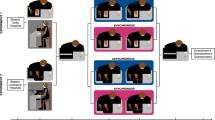Abstract
In the present research, we have investigated several characteristics of one kind of tactile illusion, called the Velvet Hand Illusion (VHI), to utilize the experimental results to generate virtual feeling of a material. In VHI, a human subject gently rubs his/her hands on both sides of a wire grid strung through a frame. The sensation produced on his/her hands is very smooth and slippery, like velvet. We focused on the VHI mechanism for new tactile displays in the virtual reality field because such tactile illusions play a useful role in deceiving the brain so that operators believe a virtual sensation is real. VHI characteristics are obtained from accomplishing a series of psychophysical experiments using Thurstone’s method of paired comparison. In the experiment, the stroke movement distance of wires, r, is varied under constant wire spacing, D; the velocity of wire movement is varied, with both wire spacing and stroke movement distance of the wires held constant. It is found that the strongest VHI was obtained at r/D≅1 and that the strongest VHI occurred at a specific velocity generating tangential vibration of around 50 Hz. Since VHI requires both compressive stress and tangential stimulus, it is caused by not just one of the four varieties of mechanoreceptive units, but two or more of them. This finding confirms that VHI does not occur in the mechanoreceptive units themselves but in the brain.
Similar content being viewed by others
References
Broren J, Rydmark M, Sunnerhagen KS (2004) Virtual reality and haptics as a training device for movement rehabilitation after stroke: a single-case study. Arch Phys Med Rehabil 85:1247–1250
Halvorsen FH, Elle OJ, Dalinin VV, Mork BE, Sorhus V, Rotnes JS, Fosse E (2006) Virtual reality simulator training equals mechanical robotic training in improving robot-assisted basic suturing skills. Surg Endosc 20:1565–1569
van der Meijden OAJ, Schijven MP (2009) The value of haptic feedback in conventional and robot-assisted minimal invasive surgery and virtual reality training: a current review. Surg Endosc 23:1180–1190
Ikei Y, Yamada M, Fukuda S (1999) Tactile texture presentation by vibratory pin arrays based on surface height maps. In: International mechanical engineering conference and exposition, pp 51–58
Tanaka M, Nara T, Tachi S, Higuchi T (2000) A tactile display using surface acoustic wave. In: 2000 IEEE international workshop on robotic and human interactive communication, pp 364–367
Tanaka Y, Hamaguchi H, Amemiya K (2002) Wearable haptic display for immersive virtual environment. In: JFPS international symposium, pp 309–310
Ohka M, Koga H, Mouri Y, Sugiura T, Mitsuya Y (2007) Figure and texture presentation capabilities of a tactile mouse equipped with a display pad stimulus pins. Robotica 25:451–460
Nakatani M, Howe RD, Tachi S (2006) The fishbone tactile illusion. EuroHaptics 69–73
Nakatani M, Sato A, Tachi S, Hayward V (2008) Tactile illusion caused by tangential skin strain and analysis in terms of skin deformation. In: Proceedings of EuroHaptics. LNCS, vol 5024. Springer, Berlin, pp 229–237
Hayward V (2008) A brief taxonomy of tactile illusion and demonstration that can be done in hardware store, Haptic Laboratory, Centre for Intelligent Machines, McGill University, Canada. Brain Res Bull 75(6):742–752
Mochiyama H, Sano A, Takasue N, Kikuue R, Fujita K, Fukuda S, Marui K, Fujimoto H (2005) Haptic illusion induced by moving line stimuli. In: Proc of world haptic conference, pp 645–648
Ohka M, Kawabe Y, Chami A, Rajaei N, Yussof HB, Miyaoka T (2010) Investigation on velvet hand illusion using psychophysics experiment and FEM analysis. Int J Smart Sensing Intel Syst 3(3)
Ohka M (2010) Two-axial piezoelectric actuator and its motion control toward tactile display. In: Next-generation actuators leading breakthrough hand book. Springer, Berlin, pp 105–116
Gescheider GA (1997) Psychophysics: the Fundamentals, Lawrence Erlbaum Associates
Bolanowaski SJ, Gescheider GA, Verrillo RT, Checkosky CM (1988) Four channels mediate the mechanical aspects of touch. J Acoust Soc Am 84:1680–1694
Miyaoka T (2005) Mechanoreceptive mechanisms to determine the shape of the detection-threshold curve. In: Proceedings of the 21st annual meeting of the international society for psychophysics, vol 21, pp 211–216
Author information
Authors and Affiliations
Corresponding author
Rights and permissions
About this article
Cite this article
Rajaei, N., Kawabe, Y., Ohka, M. et al. Psychophysical Experiments on Velvet Hand Illusion Toward Presenting Virtual Feeling of Material. Int J of Soc Robotics 4 (Suppl 1), 77–84 (2012). https://doi.org/10.1007/s12369-012-0140-4
Accepted:
Published:
Issue Date:
DOI: https://doi.org/10.1007/s12369-012-0140-4



